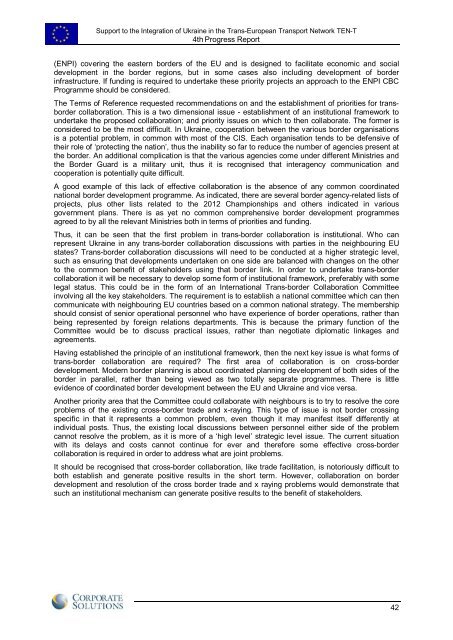Progress Report 4
Progress Report 4
Progress Report 4
You also want an ePaper? Increase the reach of your titles
YUMPU automatically turns print PDFs into web optimized ePapers that Google loves.
Support to the Integration of Ukraine in the Trans-European Transport Network TEN-T<br />
4th <strong>Progress</strong> <strong>Report</strong><br />
(ENPI) covering the eastern borders of the EU and is designed to facilitate economic and social<br />
development in the border regions, but in some cases also including development of border<br />
infrastructure. If funding is required to undertake these priority projects an approach to the ENPI CBC<br />
Programme should be considered.<br />
The Terms of Reference requested recommendations on and the establishment of priorities for transborder<br />
collaboration. This is a two dimensional issue - establishment of an institutional framework to<br />
undertake the proposed collaboration; and priority issues on which to then collaborate. The former is<br />
considered to be the most difficult. In Ukraine, cooperation between the various border organisations<br />
is a potential problem, in common with most of the CIS. Each organisation tends to be defensive of<br />
their role of ‘protecting the nation’, thus the inability so far to reduce the number of agencies present at<br />
the border. An additional complication is that the various agencies come under different Ministries and<br />
the Border Guard is a military unit, thus it is recognised that interagency communication and<br />
cooperation is potentially quite difficult.<br />
A good example of this lack of effective collaboration is the absence of any common coordinated<br />
national border development programme. As indicated, there are several border agency-related lists of<br />
projects, plus other lists related to the 2012 Championships and others indicated in various<br />
government plans. There is as yet no common comprehensive border development programmes<br />
agreed to by all the relevant Ministries both in terms of priorities and funding.<br />
Thus, it can be seen that the first problem in trans-border collaboration is institutional. Who can<br />
represent Ukraine in any trans-border collaboration discussions with parties in the neighbouring EU<br />
states? Trans-border collaboration discussions will need to be conducted at a higher strategic level,<br />
such as ensuring that developments undertaken on one side are balanced with changes on the other<br />
to the common benefit of stakeholders using that border link. In order to undertake trans-border<br />
collaboration it will be necessary to develop some form of institutional framework, preferably with some<br />
legal status. This could be in the form of an International Trans-border Collaboration Committee<br />
involving all the key stakeholders. The requirement is to establish a national committee which can then<br />
communicate with neighbouring EU countries based on a common national strategy. The membership<br />
should consist of senior operational personnel who have experience of border operations, rather than<br />
being represented by foreign relations departments. This is because the primary function of the<br />
Committee would be to discuss practical issues, rather than negotiate diplomatic linkages and<br />
agreements.<br />
Having established the principle of an institutional framework, then the next key issue is what forms of<br />
trans-border collaboration are required? The first area of collaboration is on cross-border<br />
development. Modern border planning is about coordinated planning development of both sides of the<br />
border in parallel, rather than being viewed as two totally separate programmes. There is little<br />
evidence of coordinated border development between the EU and Ukraine and vice versa.<br />
Another priority area that the Committee could collaborate with neighbours is to try to resolve the core<br />
problems of the existing cross-border trade and x-raying. This type of issue is not border crossing<br />
specific in that it represents a common problem, even though it may manifest itself differently at<br />
individual posts. Thus, the existing local discussions between personnel either side of the problem<br />
cannot resolve the problem, as it is more of a ‘high level’ strategic level issue. The current situation<br />
with its delays and costs cannot continue for ever and therefore some effective cross-border<br />
collaboration is required in order to address what are joint problems.<br />
It should be recognised that cross-border collaboration, like trade facilitation, is notoriously difficult to<br />
both establish and generate positive results in the short term. However, collaboration on border<br />
development and resolution of the cross border trade and x raying problems would demonstrate that<br />
such an institutional mechanism can generate positive results to the benefit of stakeholders.<br />
42


